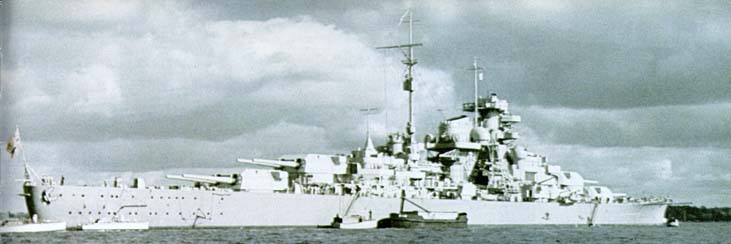GERMANIA
REICHSMARINE
![]()
![]()
![]()
![]()
![]()
![]()
![]()
![]()
![]()
![]()
![]()
NAVE DA BATTAGLIA BISMARCK
CORAZZATA BISMARCK
BATTLESHIP BISMARCK
SCHLACHTSCIFF KMS BISMARCK

MODIFICHE / CHANGES
(Tratto da: "Grandi navi da battaglia tedesche della Seconda Guerra Mondiale" di M.J. Whitley, 1989)
Gli
impianti radar della Bismarck vennero installati durante la
costruzione, con le antenne sulle pareti frontali dei telemetri di trinchetto e
di poppa. Il telemetro da 10 m della torre A venne eliminato durante o dopo le
prove della nave, e gli scudi sferici non vennero mai installati alle torri C e
D della contraerea.
La
Tirpitz venne costruita senza telemetro alla torre A aveva le torri
contraeree di poppa protette da scudi sferici. Le esperienze nell'Atlantico dell'Admiral
Hipper, della Scharnhost e della Gneisenau nel 1940-41,
portarono all'installazione di due file quadruple di lanciasiluri sul ponte di
coperta subito dietro le catapulte prima che la nave partisse per la
Norvegia nel 1942.A quel tempo erano già stati aggiunti quattro Vierling, due
sulle piattaforme di trinchetto e due sulla sovrastruttura fra le torri di
contraerea C e D. Le mitragliere singole da 2 cm furono spostate
immediatamente a poppa della torre B sul ponte di navigazione a casseretto. Con
quattordici bocche singole e quattro quadruple la dotazione da 2 cm arrivava così
a un totale di 30 mitragliere. Vennero aggiunti anche due impianti radar con
relative postozioni per gli operatori, uno sul telemetro di trinchetto e uno su
quello di prua. Gli altri due telemetri vennero protetti con schermi,
probabilmente in previsione del freddo artico.
Altri
due Vierling vennero aggiunti poco dopo l'arrivo della Tirpitz in
Norvegia, uno in sostituzione delle due bocche singole da 2 cm sul ponte di
navigazione, e il secondo con un piedistallo sul tetto della torre B. Nel corso
della guerra, la contraerea leggera aumentò ulteriormente con l'aggiunta di
altri Vierling. Due al posto delle bocche singole sulla piattaforma del fumaiolo
e altri due a casseretto dietro la torre D. I rapporti ufficiali assegnano alla Tirpitz
per il 1944 una contraerea leggera di sedici Vierling più sedici
mitragliere singole, per un totale di ottanta bocche da 2 cm.
Il radar venne migliorato ne11943-44 con I'installazione di un rilevatore d'altezza Wiirtzburg alla base dell'albero maestro che era già stato eliminato quando la nave fu affondata.
(Taken from "Great German Battleships of World War II" by MJ Whitley, 1989)
The radar equipment of the Bismarck were installed during construction, with antennas on the front wall of the finders of foremast and aft. The rangefinder 10 m of the tower was removed during or after the tests of the ship, and spherical shields were never installed on towers C and D of the flak.
The Tirpitz was built without a rangefinder to the tower to the towers was protected by anti-aircraft aft spherical shields. The experiences of the Admiral Hipper in the Atlantic, and the Scharnhost the Gneisenau in 1940-41, led to the installation of two rows of quadruple launchers on deck just behind the catapults before the ship left for Norway in 1942.A that time had already added four Vierling, on two platforms foremast and two on the superstructure between the towers of anti-C and D.
The gunner from each cm 2 were moved just behind the bridge tower B navigation poop. With fourteen individual ports and four quadruple the budget came from 2 cm to a total of 30 guns. Were added to two radar systems with relative postozioni for operators, a range finder on the foremast and one on the bow. The other two rangefinders were protected by screens, probably in anticipation of the arctic cold.
Vierling other two were added shortly after the arrival of the Tirpitz in Norway, one replacing the two individual ports by 2 cm on the navigation bridge, and the second with a stand on the roof of the tower B. During the war, the anti slight increase further with the addition of other Vierling. Two instead of individual ports on the platform of the smokestack and two others to poop behind the tower D. The official reports for 1944 Tirpitz to assign a light anti-aircraft guns of sixteen plus sixteen Vierling single, for a total of eighty mouths to 2 cm.
The radar was improved ne11943-44 with a detector installation and servicing of high Wiirtzburg at the base of the mainmast, which had already been cleared when the ship was sunk.
CORAZZATA BISMARCK /STORIA E CARATTERISTICHE TECNICHE / HISTORY
CORAZZATA BISMARCK / BATTLESHIPS BISMARCK
CACCIA ALLA BISMARCK / THE HUNTING OF THE BISMARCK
BATTAGLIE NAVALI / NAVAL BATTLES
NAVI DA GUERRA /WARSHIPS AND BATTLESHIPS